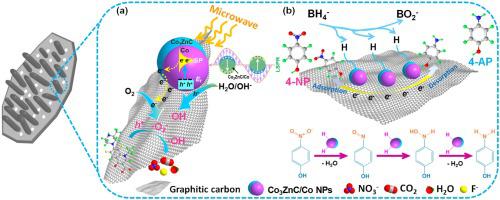Applied Catalysis B: Environment and Energy ( IF 20.2 ) Pub Date : 2020-09-01 , DOI: 10.1016/j.apcatb.2020.119513 Xueyan Liu , Lanzhen Wu , Tingting Liu , Lei Zhang

|
A novel 1D-2D hierarchical catalyst comprising of Co3ZnC/Co nanoparticles (NPs) confined in N-doped carbon nanotube-grafted graphitic carbon nanoflakes (Co3ZnC/Co@NCNTFs) has been reasonably designed and constructed in situ by controllable pyrolysis of bimetallic CoZn-ZIF in N2. The 1D N-doped CNTs with closed ends can afford fast electron transportation path, extra interface/dipole polarization, more exposed active sites as well as hierarchical structure to achieve excellent charge transfer and microwave (MW)-harvesting ability. Benefiting from the grafted CNTs structure, well-dispersed/confined Co3ZnC/Co NPs, thin carbon protective layer as well as good impedance matching, the resulting Co3ZnC/Co@NCNTFs exhibit remarkable catalytic activities in both MW-driven oxidation of lomefloxacin (LOM) and direct reduction of 4-nitrophenol (4-NP). Moreover, the oxidation and reduction process can be well-explained by Localized surface plasmon resonance (LSPR) effect and electronic relay mechanism, respectively. This work offers a simple strategy to construct 1D-2D architectures in situ and elucidates their potential applications in environmental water restoration.
中文翻译:

N掺杂碳纳米管接枝石墨碳纳米薄片中的Co 3 ZnC / Co作为一维-2D分层催化剂的原位限制,具有优异的氧化还原活性
通过可控制的热解过程,合理地设计和构造了一种新型的一维二维分层催化剂,该催化剂由限制在氮掺杂碳纳米管接枝的石墨碳纳米薄片(Co 3 ZnC / Co @ NCNTFs)中的Co 3 ZnC / Co纳米颗粒(NP)构成N 2中双金属CoZn-ZIF的合成。具有封闭端的1D N掺杂CNT可提供快速的电子传输路径,额外的界面/偶极极化,更多的暴露活性位点以及分层结构,以实现出色的电荷转移和微波(MW)捕获能力。得益于接枝的CNT结构,良好分散/约束的Co 3 ZnC / Co NP,薄碳保护层以及良好的阻抗匹配,所得的Co 3ZnC / Co @ NCNTFs在MW驱动的洛美沙星(LOM)氧化和4-硝基苯酚(4-NP)的直接还原中均表现出显着的催化活性。此外,氧化和还原过程可以分别通过局部表面等离子体共振(LSPR)效应和电子中继机制得到很好的解释。这项工作提供了一种就地构建1D-2D架构的简单策略,并阐明了它们在环境水修复中的潜在应用。











































 京公网安备 11010802027423号
京公网安备 11010802027423号